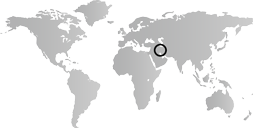The Qajar dynasty brings to an end a long period of political instability, reuniting Iranian territory after the disunity and warfare that characterized much of the eighteenth century. This period witnesses a transition from tribal to centralized rule. Iran becomes entangled in a web of superpower rivalry (between Britain and Russia) and suffers significant losses in the Caucasus. This prompts a program of modernization that results in an unprecedented influx of military, technological, and educational innovations from Europe. Artistic innovations follow. Court poets revive the simplicity and elegance of classical poetry of the tenth and eleventh centuries. Fath ‘Ali Shah Qajar (r. 1797–1834) sends a number of his sons and grandsons to the provinces as governors in an effort to centralize control. He initiates an extensive program of architectural construction in the capital and the provinces and commissions an unprecedented number of lifesize paintings for these palaces and pavilions. Local governors follow suit. Fath ‘Ali Shah also commissions portraits of himself as diplomatic gifts for foreign rulers and dignitaries. Portraits of the ruler and his court are not limited to lifesize but appear in small scale on lacquer and enamel objects as well. Fath ‘Ali Shah revives the art of rock-relief sculpture associated with the ancient Persian dynasties, the Achaemenids (550–330 B.C.) and the Sasanians (224-651) and places them alongside those of his ancient predecessors. During the reign of his successor, Muhammad Shah (r. 1834–48), commissions of lifesize and monumental paintings decline and court patronage shifts to small-scale painting in lacquer.
In the second half of the century, the Babi movement gains momentum and ultimately leads to the birth of a new religion, Bahaism. Mirza Taqi Khan, known as Amir Kabir (prime minister under Nasir al-Din Shah, r.1848–96), embarks on a state-sponsored program of military, financial, and educational reform, most importantly the establishment of Iran’s first modern institution of higher learning, the Dar al-Funun, in 1851. The years following his execution in 1852 are characterized by relative peace combined with compromises in foreign affairs and sporadic reform initiatives. Artists such as Abu’l Hasan Ghaffari, called Sani‘ al-Mulk (ca. 1814–1866), and Muhammad Ghaffari, called Kamal al-Mulk (1852–1940), study in Europe and introduce academic painting in the European style. Sani‘ al-Mulk establishes a painting academy at the Dar al-Funun and Kamal al-Mulk opens Iran’s first Academy of Fine Arts in 1911. With the introduction of photography in the 1840s, photographs are increasingly used as models for painting. After a series of trips to Europe, the shah opens the country’s first royal museum and places his collection on display. Iran erects pavilions and displays artifacts and art objects at the world’s fairs in Paris in 1867, 1878, and 1900, and in Vienna in 1873. Many artists, however, continue to work in traditional and revivalist styles.
Toward the end of his reign, Nasir al-Din Shah grants several concessions to European companies, fueling opposition to the regime. An atmosphere of public discontent, social ferment, and repression spurs protest movements and finally the Constitutional Revolution.
, 1800–1900 A.D..jpg)

, 1800–1900 A.D..jpg)